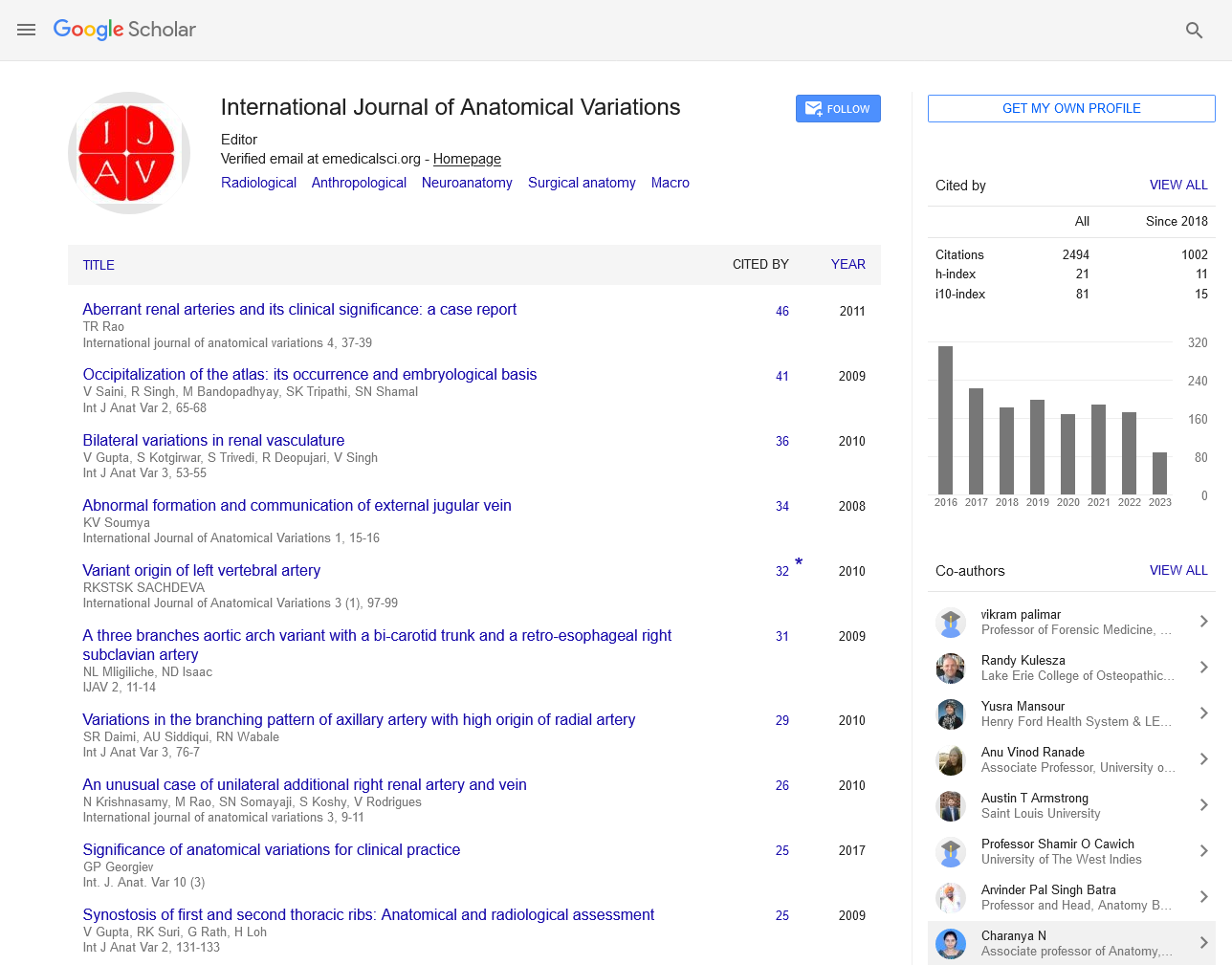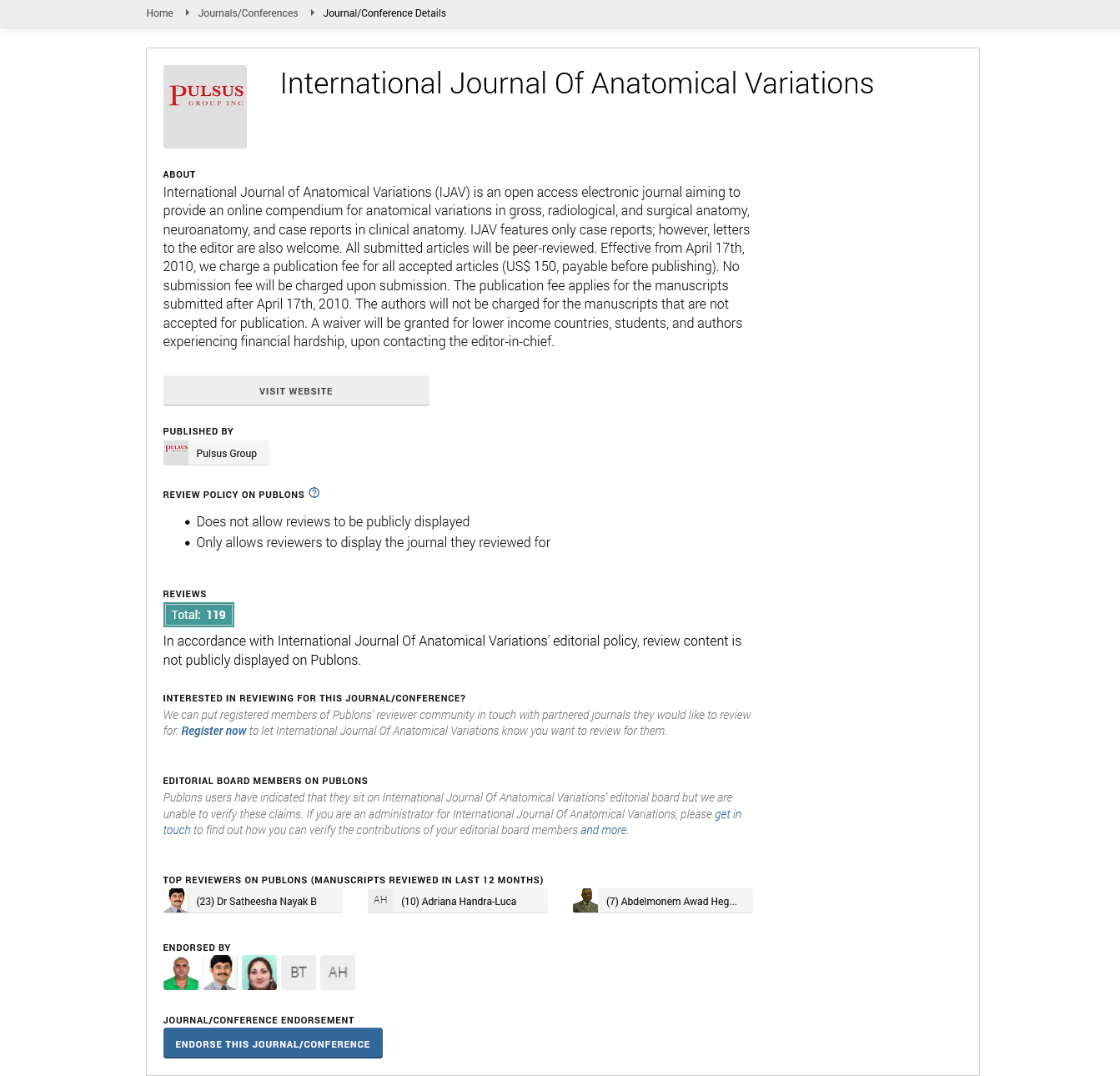Comparative Anatomy Exploring Structural Similarities and Evolutionary Relationships Across Species
Received: 01-Apr-2025, Manuscript No. ijav-25-7673; Editor assigned: 04-Apr-2025, Pre QC No. ijav-25-7673 (PQ); Reviewed: 21-Apr-2025 QC No. ijav-25-7673; Revised: 26-Apr-2025, Manuscript No. ijav-25-7673 (R); Published: 30-Apr-2025, DOI: 10.37532/13084038.18(4).507
Citation: Yadav A. Comparative Anatomy Exploring Structural Similarities and Evolutionary Relationships across Species. Int J Anat Var. 2025; 18(4): 781-782.
This open-access article is distributed under the terms of the Creative Commons Attribution Non-Commercial License (CC BY-NC) (http://creativecommons.org/licenses/by-nc/4.0/), which permits reuse, distribution and reproduction of the article, provided that the original work is properly cited and the reuse is restricted to noncommercial purposes. For commercial reuse, contact reprints@pulsus.com
Abstract
Comparative anatomy, the study of similarities and differences in the anatomical structures of different organisms, provides crucial insights into evolutionary biology. By examining homologous and analogous structures, scientists can trace the evolutionary pathways that link diverse life forms and unravel the complex processes of natural selection and adaptation. This article reviews the historical development, methodologies, and contemporary significance of comparative anatomy in the context of evolutionary theory, developmental biology, and functional morphology. Special emphasis is placed on vertebrate anatomy, showcasing examples from mammals, birds, reptiles, and fish to illustrate shared traits and divergent adaptations.
INTRODUCTION
Comparative anatomy is a foundational discipline in biological sciences that investigates the anatomical similarities and differences among species [1]. It has played a pivotal role in shaping modern evolutionary theory since the days of Georges Cuvier and Charles Darwin. By comparing body structures—such as skeletal systems, musculature, and organ layouts—researchers gain a deeper understanding of how organisms are related and how their features have adapted over time.
HISTORICAL BACKGROUND
The roots of comparative anatomy stretch back to ancient Greece, where philosophers such as Aristotle made early observations on the structures of animals. In the 18th and 19th centuries, anatomists like Georges Cuvier and Richard Owen formalized the discipline [2]. Cuvier emphasized functional anatomy and the correlation of parts, whereas Owen distinguished between homologous and analogous structures. Charles Darwin’s theory of evolution by natural selection provided the framework to interpret anatomical similarities as evidence of common ancestry [3].
CONCEPTS IN COMPARATIVE ANATOMY
Homologous structures are anatomical features that arise from a common ancestor but may serve different functions in modern species. For instance, the forelimbs of humans, whales, bats, and birds all share a similar bone structure, despite being adapted for tasks as diverse as grasping, swimming, and flying [4]. **Analogous structures** perform similar functions but evolved independently, not from a common ancestor. An example is the wings of birds and insects—both used for flying but structurally and developmentally different. These are remnants of structures that were functional in an ancestor but are reduced or unused in modern species. The human appendix and pelvic bones in whales are notable examples.
METHODOLOGIES IN COMPARATIVE ANATOMY
Comparative anatomy employs various methods to investigate structural similarities and differences. Traditional methods of dissecting and comparing physical structures. Microscopic examination of tissues to study fine anatomical details. CT scans, MRI, and 3D modeling enhance visualization of internal structures. Combining anatomical data with genetic information to construct evolutionary trees [5].
COMPARATIVE ANATOMY ACROSS VERTEBRATE GROUPS
Mammals exhibit a highly conserved skeletal layout with adaptations for various lifestyles. The pentadactyl limb (five-digit limb) is a hallmark of mammalian anatomy, diversified into hands, hooves, and flippers. Birds evolved from theropod dinosaurs and show modified forelimbs into wings. Hollow bones and a keeled sternum are adaptations for flight. Reptiles present a range of limb modifications, including fully terrestrial limbs and the limb loss seen in snakes. Their skull and jaw structures vary significantly and provide clues to dietary adaptations. **Fish** possess streamlined bodies and fins adapted for aquatic life. Comparing the gill structures and swim bladders of different species reveals evolutionary transitions to land-dwelling forms.
FUNCTIONAL AND EVOLUTIONARY IMPLICATIONS
Understanding comparative anatomy allows scientists to infer how structures evolved to meet functional demands. It bridges evolutionary biology with biomechanics and ecology, explaining how anatomical constraints influence the trajectory of natural selection. For example, the evolution of the mammalian middle ear bones from jawbones in early vertebrates highlights a transition that improved hearing capacity.
CHALLENGES AND FUTURE DIRECTIONS
The integration of molecular biology with anatomical data presents challenges in reconciling morphological and genetic phylogenies. Advances in computational modeling and genomics are expected to refine our understanding of structural evolution and organismal diversity.
CONCLUSION
Comparative anatomy remains a cornerstone of evolutionary biology, providing vital evidence of common ancestry and adaptive innovation. As scientific tools evolve, so too will our capacity to explore the deep connections between structure and function across the tree of life.
REFERENCES
- Park K-M, Yang S-S, Kim Y-W, Park KB, Park HS, et al. Clinical outcomes after internal iliac artery embolization prior to endovascular aortic aneurysm repair. Surg Today 2014; 44:472-477.
- Patel SD, Perera A, Law N, Mandumula S. A novel approach to the management of a ruptured Type II endoleak following endovascular repair of an internal iliac artery aneurysm. Br J Radiol. 2011; 84(1008):e240-2.
- Szymczak M, Krupa P, Oszkinis G, Majchrzycki M. Gait pattern in patients with peripheral artery disease. BMC Geriatrics. 2018; 18:52.
- Albulescu D, Constantin C, Constantin C. Uterine artery emerging variants - angiographic aspects. Current Health Sciences Journal 2014; 40:214-216.
- Osher M, Semaan D, Osher D. The uterine arteries, anatomic variation and the implications pertaining to uterine artery embolization. J Vasc Interv Radiol 2014; 25:S143.
Indexed at, Google Scholar, Crossref
Indexed at, Google Scholar, Crossref
Indexed at, Google Scholar, Crossref
Indexed at, Google Scholar, Crossref






